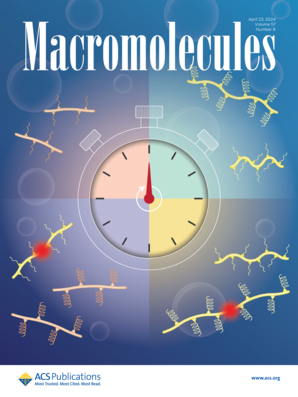One-Step, Four-Fold Schiff Base Reaction Constructing a Highly Fused π-Extended Lactam Acceptor toward n-Type Polymer
IF 5.1
1区 化学
Q1 POLYMER SCIENCE
引用次数: 0
Abstract
Fused lactam electron-deficient building blocks are significant for the advancement of n-type donor–acceptor (D–A) polymeric semiconductors; however, they are rarely reported due to the challenges associated with tedious synthetic routes, strict experimental operations, multiple purifications, and unstable intermediates. Herein, a highly fused electron-deficient lactam building block, as a novel acceptor unit, 6,15-bis(4-octadecyldocosyl)-6,15-dihydroisoquinolino[3,4-b]isoquinoline[4’,3′:5,6]pyrazino[2,3-g]quinoxaline-5,14-dione (IIPQD), was easily synthesized via a one-step 4-fold Schiff base reaction. This IIPQD unit features a rigid π-extended conjugation skeleton, which facilitates the construction of planar polymer backbones and dense, ordered packing motifs for charge transport, as well as a strong electron-withdrawing capacity for electron injection, stemming from the synergistic electron-withdrawing effects of its lactam structures and 1,4-pyrazine moieties. Consequently, the IIPQD-based D–A copolymer PIIPQD-BTF showed typical n-type charge transport characteristics. These results highlight that Schiff base synthesis of fused π-extended electron-deficient lactam building blocks has great potential in developing electron-deficient building blocks and n-type polymer semiconductors.

一步四重席夫碱反应构建n型聚合物的高融合π扩展内酰胺受体
熔融内酰胺缺电子构建块对n型给受体(D-A)聚合物半导体的发展具有重要意义;然而,由于与繁琐的合成路线、严格的实验操作、多次纯化和不稳定的中间体相关的挑战,它们很少被报道。本研究以6,15-双(4-十八烷基十二烷基)-6,15-二氢异喹啉[3,4-b]异喹啉[4 ',3 ':5,6]吡嗪[2,3-g]喹诺啉-5,14-二酮(IIPQD)为受体单元,通过一步四重席夫碱反应合成了高度融合的缺电子内酰胺构建块。该IIPQD单元具有刚性π-扩展共轭骨架,有利于构建平面聚合物骨架和密集有序的填充基序进行电荷输运,同时由于其内酰胺结构和1,4-吡嗪基团的协同吸电子作用,具有很强的吸电子能力进行电子注入。因此,基于iipqd的D-A共聚物PIIPQD-BTF具有典型的n型电荷输运特性。这些结果表明,Schiff碱合成的融合π扩展缺电子内酰胺构建块在开发缺电子构建块和n型聚合物半导体方面具有很大的潜力。
本文章由计算机程序翻译,如有差异,请以英文原文为准。
求助全文
约1分钟内获得全文
求助全文
来源期刊

Macromolecules
工程技术-高分子科学
CiteScore
9.30
自引率
16.40%
发文量
942
审稿时长
2 months
期刊介绍:
Macromolecules publishes original, fundamental, and impactful research on all aspects of polymer science. Topics of interest include synthesis (e.g., controlled polymerizations, polymerization catalysis, post polymerization modification, new monomer structures and polymer architectures, and polymerization mechanisms/kinetics analysis); phase behavior, thermodynamics, dynamic, and ordering/disordering phenomena (e.g., self-assembly, gelation, crystallization, solution/melt/solid-state characteristics); structure and properties (e.g., mechanical and rheological properties, surface/interfacial characteristics, electronic and transport properties); new state of the art characterization (e.g., spectroscopy, scattering, microscopy, rheology), simulation (e.g., Monte Carlo, molecular dynamics, multi-scale/coarse-grained modeling), and theoretical methods. Renewable/sustainable polymers, polymer networks, responsive polymers, electro-, magneto- and opto-active macromolecules, inorganic polymers, charge-transporting polymers (ion-containing, semiconducting, and conducting), nanostructured polymers, and polymer composites are also of interest. Typical papers published in Macromolecules showcase important and innovative concepts, experimental methods/observations, and theoretical/computational approaches that demonstrate a fundamental advance in the understanding of polymers.
 求助内容:
求助内容: 应助结果提醒方式:
应助结果提醒方式:


